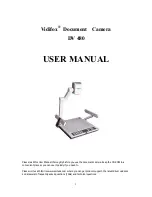
STINGRAY Instruction Leaflet
V2.2.0
5
STINGRAY Instruction Leaflet
V2.2.0
6
STINGRAY Instruction Leaflet
V2.2.0
7
STINGRAY Instruction Leaflet
V2.2.0
8
Hardware Installation
To install hardware read
Hardware Installation Guide
.
Software Installation
To install software read (depending on your system):
•
FirePackage User Guide
•
FirePackage64 User Guide
•
Fire4Linux User Guide
Note
L
You will find this document in the following directory:
<CD ROM>:\products\cameras-general
•
All_HardInst_Vx.y.z_en.pdf
Note
L
You will find these documents in the following directory:
<CD ROM>:\products\AVT_FirePackage_x_y_z
•
FirePackage_UserGuide_Vx.y.z_en.pdf
•
FirePackage_x64_UserGuide_Vx.y.z_en.pdf
<CD ROM>:\products\linux
Safety instructions
Cautions
Note
L
•
There are no switches or parts inside the camera that
require adjustment. The guarantee becomes void upon
opening the camera casing.
•
If the product is disassembled, reworked or repaired by
other than a recommended service person, AVT or its
suppliers will take no responsibility for the subsequent
performance or quality of the camera.
•
The camera does NOT generate dangerous voltages
internally. However, because the IEEE 1394b standard
permits cable power distribution at voltages higher
than 24 V, various international safety standards apply.
Note
L
•
All
color models
are equipped with an
optical filter
to
eliminate the influence of infrared light hitting the
sensor. Please be advised that, as a side effect, this fil-
ter reduces sensitivity in the visible spectrum. The opti-
cal filter is part of the back focus ring, which is
threaded into the C-Mount.
•
B/w models
come with a
sensor protection glass
mounted in the back focus ring.
Caution
a
Hot-plug precautions
•
Although FireWire devices can
theoretically
be hot-
plugged without powering down equipment,
we
strongly recommend turning the computer power off,
before connecting a digital camera
to it via a FireWire
cable.
•
Static electricity or slight plug misalignment during
insertion may short-circuit and damage components.
Caution
a
Hot-plug precautions
•
The physical ports
may be damaged
by
excessive ESD
(electrostatic discharge), when connected under powered
conditions. It is good practice to ensure proper grounding
of computer case and camera case to the same ground
potential, before plugging the camera cable into the port
of the computer. This ensures that no excessive difference
of electrical potential exists between computer and cam-
era.
•
It is
very
important
not
to exceed an inrush current of
18 mJoule in 3 ms. (This means that a device, when pow-
ered via 12 V bus power must
never
draw more than 1.5 A,
even not in the first 3 ms.)
•
Higher inrush current may damage the physical inter-
face chip of the camera and/or the phy chip in your PC.
•
Whereas inrush current is not a problem for one Pike/Stin-
gray camera, daisy chaining multiple cameras or supplying
bus power via (optional) HIROSE power out to circuitry
with unknown inrush currents needs careful design consid-
erations to be on the safe side.
Screw-lock and other precautions
•
Also, all AVT 1394b camera and cables have
industrial
screw-lock fasteners
, to insure a tight electrical connec-
tion that is resistant to vibration and gravity.
•
We strongly recommend using only 1394b adapter
cards with screw-locks.
•
Make sure
not
to touch the shield of the camera cable
connected to a computer and the ground terminal of the
lines at the same time.
•
If you are charged: before touching the shield of the cam-
era cable, make sure to discharge first (by touching the
ground terminal of the lines).
•
Use only DC power supplies with insulated cases. These are
identified by having
only two
power connectors.
•
If you feel uncomfortable with the previous advice or if
you have no knowledge about the connectivity of an
installation,
we strongly recommend powering down all
systems before connecting or disconnecting a camera.
Environmental conditions
•
Ambient temperature (when camera in use):
+ 5 °C ... + 45 °C
•
Ambient temperature during storage:
- 10 °C ... + 60 °C
•
Relative humidity:
20 % … 80 % without condensation
•
Protection:
IP 30
Copyright
All texts, pictures and graphics are protected by copyright and other laws pro-
tecting intellectual property. It is not permitted to copy or modify them for trade
use or transfer, nor may they be used on web sites.
Allied Vision Technologies GmbH 08/2008
All rights reserved.
Managing Director: Mr. Frank Grube
Tax ID: DE 184383113
Caution
a
•
Mount/dismount lenses and filters in a
dust-free envi-
ronment
, and
do not
use compressed air (which can push
dust into cameras and lenses).
•
Use only
optical quality tissue
/cloth if you must clean a
lens or filter.
•
Read Hardware Installation Guide, Chapter Cleaning
instructions.




















